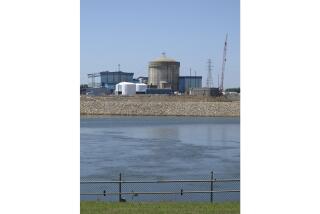More Cracks Found in Arms Reactor Pipe
- Share via
WASHINGTON — Engineers have discovered new cracks in a cooling pipe in one of the government’s nuclear weapons reactors in South Carolina, the most serious structural problem yet identified in the aging reactors, according to Reagan Administration officials and other sources.
The cracks affect the main cooling system of the L-reactor, one of three reactors at the Savannah River Plant near Aiken. They appear to be either flaws or stress-induced defects in the metal itself, rather than the more common cracking associated with welds, the sources said.
Only Source of Tritium
All three reactors at Savannah River are shut down. They are the nation’s only source of tritium, a perishable isotope that decays at the rate of 5.5% a year and must be replenished periodically in nuclear weapons.
One official called the problem a “potential show-stopper” that could delay restarting the reactors and possibly force a permanent shutdown of the L-reactor. The Energy Department retired a fourth reactor at Savannah River several years ago after determining that cracks in the steel shield that surrounds its core could not be repaired.
The department hopes to restart the K-reactor, a sister to the L-reactor, by next summer. Sources said that the newly discovered pipe cracks raise new questions about the state of the K-reactor, which is almost identical in design but older than the L-reactor.
The latest problem was discovered by the department’s Savannah River contractor, E. I. du Pont de Nemours & Co., during tests of an ultrasonic system designed to detect cracks not visible to the eye. Department officials were not told about the problem until this week, sources said, in part because Du Pont executives did not initially believe the results of their test.
“They thought there was something wrong with the equipment,” one source said.
The cracks are considered critical, in part because they affect the primary cooling system, which prevents overheating that could lead to a core meltdown. Should the pipe split when in operation, it could lead to the failure of the cooling system.
Officials have not determined the exact cause of the defect, but they said it is significant because it is a “base metal” crack not associated with any welds. That suggests that either the pipe has deteriorated with age or that it was improperly installed.
Engineers have long recognized that heat from a welding torch can stress metal pipes, leading to cracks and corrosion. The department disclosed Monday that it had found cracks of that type in the L-reactor, inside a section of cooling pipe where support braces had been welded on years ago.
The new cracks were found in the same piece of pipe when Du Pont engineers utilized the more sophisticated ultrasonic equipment.
Savannah River manager William Kasper said the pipe had been removed in October, 1987, because engineers had found a visible crack on it. The pipe was not analyzed for other cracks until last March, when inspectors found the defects near the support braces, he said.
The third and more serious defects were only detected recently, he added.
“Base metal” defects are considered more serious because they indicate either improper pipe installation or metal fatigue. “This is a problem that is not observed in commercial reactors,” one official said, adding that the cracks are “growing in the metal itself, not in the weld.”
Problem of Metal Fatigue
Moreover, the new cracks raise questions about virtually every pipe in the reactor. Stress from improper installation practices, such as forcing pipes into place, can weaken metal over time. Metal fatigue, a combination of age and stress, can similarly weaken even pipes that are properly installed.
Cracks caused by either problem are likely to miss detection under Savannah River’s current safety program because it emphasizes visual inspection of piping in welded areas.
In a letter delivered Thursday to Energy Secretary John S. Herrington, the department’s safety advisory committee asked department officials to explain why their restart plan for the K-reactor does not require ultrasonic testing of vessels and piping systems.
“The need for such inspections has recently been made more obvious by evidence that inspections in the past may not have included all critical regions of the reactor coolant system susceptible to stress corrosion cracking,” said the panel, which is headed by former Nuclear Regulatory Commission Chairman John F. Ahearne.
The letter concurs with Herrington that the first of the three reactors cannot be restarted “until at least next spring or summer.” It urges the department to “focus all available resources” on this task.
“At this time, we are unable to advise whether the (Savannah River) plant will meet the overall safety criteria of adequate protection to the public and the workers,” the letter said.
More to Read
Sign up for Essential California
The most important California stories and recommendations in your inbox every morning.
You may occasionally receive promotional content from the Los Angeles Times.













